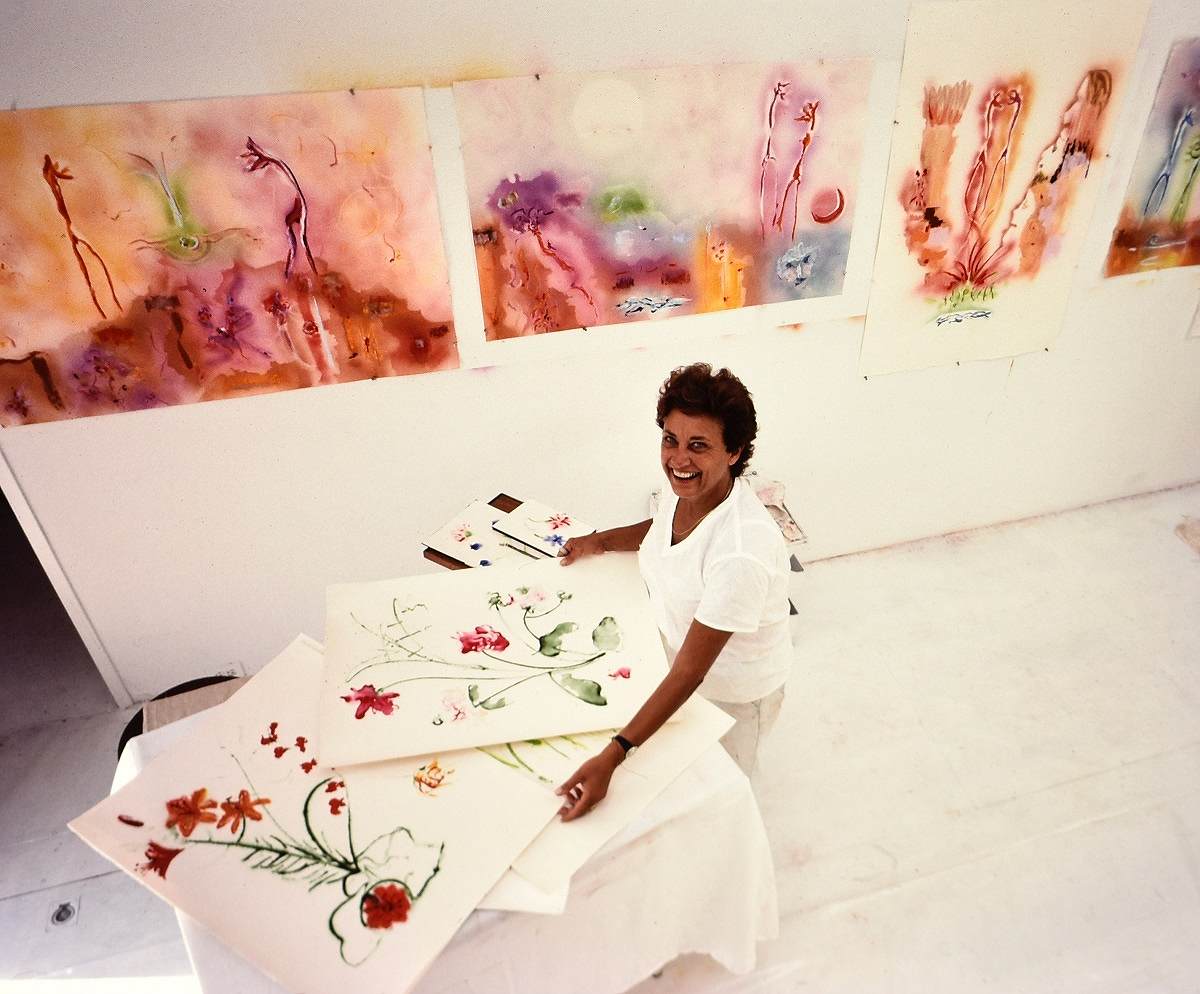
Sheila Isham at her studio in Sagaponack, N.Y., in 1982.
12:07 JST, April 13, 2024
Sheila Isham, an artist who explored color and culture in vibrant works that drew from her travels around the world and were exhibited at preeminent museums in the United States and galleries abroad, died April 9 at a hospital in Manhattan. She was 96.
The cause was pneumonia, said her son Christopher Isham.
Isham was known to her admirers as an artist whose immense creativity could be contained in “no cubbyhole,” as Washington Post art critic Paul Richard once put it.
Beginning in the 1950s, she accompanied her husband, Foreign Service officer Heyward Isham, on postings to West Berlin, Moscow, Hong Kong, Paris and Haiti, where he served as ambassador from 1974 to 1977.
Isham also spent periods in Washington, where she became known, in Richard’s description, as “one of the most subtle and consistent modernist artists in our area,” and traveled extensively in India.
At each stop, she immersed herself in the place’s artistic movements and cultural traditions – from German expressionism to Confucianism to Haitian ritual – which she combined in her art to powerful effect.
One of her most noted exhibits, presented in 1981 at what is now the Smithsonian American Art Museum, was titled “East and West: Painting/Poems by Sheila Isham” and showcased works that melded ancient Chinese calligraphy and abstract painting.
“I’ve integrated the shocks of different cultures through the process of living with them, assimilating them, unifying them through the work process,” Isham told the New York Times in 1988. “A critic recently compared my work with the way a snake sheds skins, and it’s an apt way of putting it.”
Isham also moved between abstract and figurative art. She was “not afraid,” she once remarked, “to dance back and forth.” Her abstract works included canvases filled with diaphanous color suggestive of clouds, as well as other, starker pieces in black and white.
Isham’s works were housed at the Museum of Modern Art in New York City, the Corcoran Gallery of Art in Washington, the San Francisco Museum of Modern Art and the Walker Art Center in Minneapolis, as well as at museums and galleries overseas.
“We all have our own strange destinies,” she once observed. “And each of us is sort of responsible for our own path and choosing it.”
Sheila Burton Eaton, the youngest of three sisters, was born on Dec. 19, 1927, in New York City. She grew up there, in Cedarhurst, on Long Island, and in Warrenton, Va., where her father, a banker, also owned a farm. Her mother was a homemaker.
Isham attended the private Garrison Forest School in Maryland before enrolling at Bryn Mawr College in Pennsylvania, where she received a bachelor’s degree in political science in 1950. She and Heyward Isham were married the same year.
The couple soon departed for West Berlin, where, according to the Times, Isham was the first foreigner after World War II to study at the city’s Academy of Fine Arts. West Berlin also gave Isham her first solo show, in 1954 at the Galerie Springer.
Her first exhibition in the United States, “Impressions in Black and White,” opened at the Franz Bader Gallery in Washington in 1960. The following decade, in 1972, a fire at a studio she kept in the downtown area of the District destroyed 20 years of Isham’s work, including 175 paintings and 1,000 graphics, photographs and drawings.
“I thought that the burnt studio looked like a painting, like a myth, something you might want to take the picture of,” she later said. “I had to come to terms with that. I became freer in a way.”
Isham’s husband, a top negotiator at the Paris peace talks that formally ended U.S. military involvement in the Vietnam War, died in 2009. Survivors include their son Christopher Isham, a former Washington bureau chief for CBS News, of the District; another son, Ralph Isham of Manhattan; nine grandchildren; and 14 great-grandchildren.
Isham’s daughter, Sandra Isham Vreeland, contracted HIV in a blood transfusion and died of AIDS in 1996. Isham channeled her grief into a set of paintings, the “Victoria Series,” which was exhibited at the National Museum of Women in the Arts in Washington in 2005.
“There’s a mystery out there, something beyond, that we’re not able to see,” she once told the Indianapolis Star. “That beyond is what I’m trying to represent.”
"News Services" POPULAR ARTICLE
-

American Playwright Jeremy O. Harris Arrested in Japan on Alleged Drug Smuggling
-

Japan’s Nikkei Stock Average as JGB Yields, Yen Rise on Rate-Hike Bets
-

Japan’s Nikkei Stock Average Licks Wounds after Selloff Sparked by BOJ Hike Bets (UPDATE 1)
-

Japanese Bond Yields Zoom, Stocks Slide as Rate Hike Looms
-

Japan’s Nikkei Stock Average Buoyed by Stable Yen; SoftBank’s Slide Caps Gains (UPDATE 1)
JN ACCESS RANKING
-

Keidanren Chairman Yoshinobu Tsutsui Visits Kashiwazaki-Kariwa Nuclear Power Plant; Inspects New Emergency Safety System
-

Imports of Rare Earths from China Facing Delays, May Be Caused by Deterioration of Japan-China Relations
-

University of Tokyo Professor Discusses Japanese Economic Security in Interview Ahead of Forum
-

Japan Pulls out of Vietnam Nuclear Project, Complicating Hanoi’s Power Plans
-

Govt Aims to Expand NISA Program Lineup, Abolish Age Restriction



















